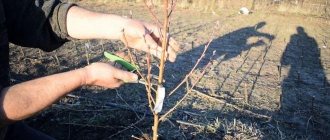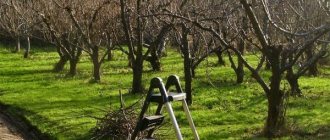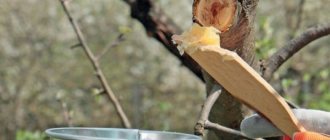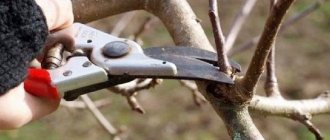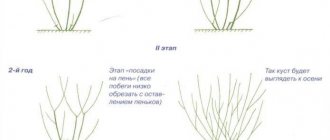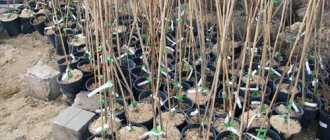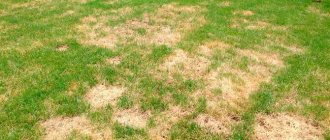The apple tree is one of the most productive crops, which, with proper care, will produce good harvests every year. How beautiful a blooming apple orchard looks in spring and an orchard that begins to bear fruit from mid-summer until the first frost.
All varieties of apple trees have their own specific fruiting period, taste, smell, color, degree of hardness and juiciness. The editors of the Agronom.guru portal will help novice gardeners navigate the issue of how to properly prune apple trees in spring and autumn. The article will also provide photo and video tutorials for beginners.
The apple tree is a real patriarch among fruit trees
Why is the crown formed and when to do it?
The formation of the “cap” is a very important process that affects the yield of a fruit tree; the branches become stronger, withstand bad climatic conditions, and do not break off in wind, snow or rain.
Pruning is necessary to create the correct shape of the top; for this purpose, strong skeletal branches are left and young fruiting ones are pinched. The main thing is to do everything correctly, otherwise you can ruin the apple tree.
Many novice gardeners skip pruning, considering it optional, but this is not true because:
- A thick and branchy crown causes branches to break off, wounds appear that do not heal, and the apple tree begins to hurt. Recovery will take a lot of effort and time, and part of the harvest will be lost. Gradually the condition of the tree will deteriorate and it will die.
- Frequent and dense foliage causes diseases; as a result, apples become tasteless and unattractive in appearance.
- An unkempt tree produces small and sour fruits. Since the sugar obtained during photosynthesis begins to be spent on leaves and branches, and not on apples. The more shoots an apple tree has, the more nutrients are spent on their maintenance, and there are not enough of them. As a result, the shoots freeze, which leads to a weakening of the plant as a whole.
- The correct shape will help to withstand the weight of the apples and not bend under its own weight, since after planting the tree is very brittle and can break from the weight of the fruit and harsh climatic conditions. Pruning can maintain a balance between the durability of the branches and the load of fruit.
- Due to the thick cap of leaves, sunlight does not reach all branches, the fruits ripen more slowly and become of poor quality. With good lighting, the fruiting period is reduced by 2 years, and the apples will be juicy and tasty, and the plant itself will grow quickly.
- A properly selected shape helps you pick fruit without any extra effort at a comfortable height.
If the tree is not cared for for four years, it will go wild, the fruits will be tasteless, sour and small.
Reasons for crown formation
When forming the crown of a tree, the gardener:
- regulates fruiting;
- stimulates the growth of young apple trees;
- takes care of increasing the tree’s resistance to adverse weather conditions (strong wind, snow).
Creating an apple tree crown by year
An apple tree left unattended quickly acquires a thick crown. From year to year, actively overgrown with a large number of young shoots, the main branches become more and more heavy. At some point in time, the crown may not be able to support its own weight, the branches will begin to break off under even very slight gusts of wind. Wounds appear at the site of the break, and the tree begins to hurt.
But even if this does not happen and the branches remain intact, the apple tree will not feel the best. Dense leaves will not allow sunlight to reach the fruit. As a result, the apples will become tasteless, lose their attractive appearance, and there will be fewer of them.
Note! An unkempt crown causes the branches to thin and begin to break, including under the weight of apples.
Tree pruning rules
Advice from experienced gardeners
Experienced gardeners advise following pruning technology, focusing on the variety of apple tree, the time of fruiting, and general appearance.
Old trees that are taken too zealously to bring them into proper condition may die. This must be taken into account, trying not to overdo it. Young and immature seedlings may also die. It is better to entrust the formation of a young apple tree to a specialist.
A gardener who knows how to form the crown of an apple tree will not find it difficult to carry out the procedure on other trees. Beginners looking for an answer to the question of how to properly form an apple tree should first study the theoretical part and only then begin practice.
Preparation for formation
It is important to choose good tools for pruning the crown: pruning shears for thin branches and a saw for thicker ones. Before work you need to sharpen them, otherwise you can damage the tree. The health of the apple tree depends on the correctness, accuracy and ease of cutting.
For large cuts over 2 cm, you will need a special garden pitch. The cuts need to be treated with a thin layer, the main thing is not to overdo it with the thickness, otherwise the varnish will flow into the mouth of the bark, blocking the access of oxygen.
All cuts should be cut correctly from bottom to top. They must be done above an already developed tree bud and at a slight angle so that water does not collect at the top of the cut.
Before forming the crown of a young tree, it is necessary to determine the approximate ratio of the cap and roots:
- If a seedling is dug up in the garden, then only part of its roots are taken, namely up to 45 cm. This length will not be able to supply nutrition to the entire crown, so the shoot must be shortened to 35 cm.
- If the seedling has widely spaced branches, then it is advisable to cut off all the cuttings to 45-50 cm from the ground.
What tools are needed for pruning?
Every gardener should have the necessary tools to work in the garden, always ready for work. To prune apple trees you will need:
- hacksaw;
- pruner;
- lopper;
- garden knife.
When using a sharp tool, you must be extremely careful so as not to injure yourself or harm the plant. Before work, the tool is washed and disinfected so as not to introduce disease and insect pests through the cut. Saws must be well sharpened, since a blunt tool can tear the bark of a tree when pruning and cause irreparable harm to it.
All garden tools must be well sharpened
Terms of formation
The formation of the crown of an apple tree means the creation of a type that is optimally suited to the growing conditions of a particular variety.
Moreover, the process of forming the crown of an apple tree begins almost from the moment you planted an apple tree seedling. And it ends differently for each variety and method.
- Experts believe that for an apple tree this is 7-12 years. But in early-fruiting and low-growing varieties, it is 2-4 years earlier than in late and vigorous-growing varieties;
- In the winter-spring period, it is recommended to form apple trees up to 3-4 years old and only when the frost does not exceed 15 ° C;
- In the summer (until August) it is more effective and useful not to use pruning, but simply bending, bending, pinching;
- But you can work on the crown of winter-hardy apple tree varieties from November to February;
- When the apple trees already bear fruit (this is about 5 years of age), they are pruned to form a crown after 2-3 years.
Attention!
- You begin to form a spindle-shaped crown already in the 2nd year, and all other types of crown - immediately after planting the apple tree;
- Branches growing at sharp angles, less than 40°, are often susceptible to fractures (when overloaded with crops, unfavorable weather conditions).
Work in spring, autumn
We have already considered the most suitable time and timing for the formation of the crown of an apple tree with various rootstocks.
What you should strive for when forming the crown, and what you need to ensure:
- Ability to withstand maximum yields;
- Compact, uniform and small in size;
- The best illumination of all parts of the tree (bottom and top);
- Ease of harvesting;
- Early fruiting.
This is solved by using certain actions, techniques and operations.
- Shortening and thinning using pruning;
- By bending, deflecting, interweaving shoots to regulate the harvest and create a decorative apple tree (although it does not bear fruit very well, it is original and is a decoration for the garden).
Interestingly:
- First of all, they consider the possibilities of adjustments without deletions, and only then trimming;
- You can use one of the methods, techniques, or in combination.
And what is important:
- Carry out all work on crown formation at the appropriate time of day (preferably morning) and dry weather (especially when pruning);
- Coordinate your actions with the lunar calendar.
Methods of crown formation
To give the crown of an apple tree the desired shape, the following methods are used:
- Pruning – allows you to regulate the growth of the tree. Depending on the time of the event it may be:
- winter (spring) - carried out in early spring before the start of sap flow, but after the threat of return frosts has passed;
- summer - carried out as necessary, in case of unwanted shoots;
- autumn - the formation of the crown after harvesting, but 1 month before the onset of frost.
- Green operation - pinching or removing young and immature shoots.
- Blinding (removal) of the buds - prevents the appearance of excess shoots, saves nutrients, redirecting them in the right direction. The least traumatic way.
- Bending and fixing branches - allows you to regulate growth, changes the purpose of the branches. The desired direction is given by hanging weights, installing spacers or tightening.
- Grafting - used to fill voids in the crown.
Basic schemes
There are several schemes for forming a tree crown. The choice depends on the variety and sometimes the weather conditions in which the tree grows. To give the crown the desired shape, use the following methods:
- pruning (allows you to regulate tree growth);
- green operations (pinching, getting rid of adult but not mature shoots);
- cutting off the buds (the growth of shoots that can become redundant stops).
Important! The branches of the apple tree can be bent and secured in the desired direction. Grafting is also used to fill voids in the crown (the yield depends on the quality of the rootstock).
Tiered-discharged crown scheme
Almost natural type of branch growth. To shape the apple tree:
- a tree at the age of 1-2 years must be pruned at a height of 70-100 cm, the cut is made on the bud opposite the scion site;
- in three-year-olds, the top is cut off again; 5 buds should be left on the last branches;
- in the fourth year, skeletal branches of all tiers are distinguished, the lower tier is created from 3 branches, and the upper from 2-3.
An adult tree is a multi-tiered sparse structure of 8 skeletal branches. The growing crown must be constantly trimmed so that the height of the tree does not exceed 3-4 meters. To achieve this, the conductor in the center is completely cut off. It is replaced by a side branch, which is located below. Excess branches facing south are cut off, and those facing north are shortened. If the length of the branches does not exceed 30 cm, they are not touched; fruits form on them. The optimal height of the trunk is 50-120 cm. The cooler the climate (Siberia, Ural), the shorter the trunk should be.
Tiered-sparse or almost natural crown
Vertical palmette
The formation of the crown of the apple tree begins with the skeletal branches. Everything on the sides must be cut off. As the tree grows, any branches that stray from one row are removed.
Spring pruning
Fusiform
In the fall, using spacers, all new shoots are bent, giving them a horizontal position. In spring, the main branch is cut 30-60 cm from the top. Pruning is carried out annually for 7 years. The apple tree should not grow more than 3 m, and horizontal branches should not reach a length of 1.5 m. The crown should be round in shape.
Note! The main disadvantage of spindle pruning is that it is necessary to correct the result annually.
creeping
Strong branches bend until they reach a horizontal position. This is done with the help of stretch marks. Such a crown can withstand heavy loads, does not break under the weight of snow, and is resistant to gusts of wind.
Bush-like
5-6 strong branches remain on the trunk, all the rest are removed. Next year's shoots are pruned with a herringbone pattern. Annual layerings are cut to 0.5 of their previous length. The branch located in the center is shortened.
A bush-like crown is made only when the tree shoots branch well. Otherwise, such pruning may harm the apple tree.
Whorled-tiered
There are 4 branches on each tier; the distance between tiers should not be less than 1.5 meters. The taller the tree, the more tiers are created.
The crown of the apple tree can also be shaped into a bowl.
Features of the procedure
The gardener will have to work hard to bring the crown into the desired form for no more than 4-5 years. Once this milestone is overcome, he will only have to periodically trim the young shoots, which is not difficult. But the procedure itself can cause confusion at the initial stage (from the moment of disembarkation). Some trees are tied to a trellis, others are dwarf or semi-dwarf (for example, the President variety). This will have to be taken into account both when planting and during subsequent pruning.
Trellis apple trees
Working with trees on a trellis
To ensure that the strongest shoots grow in two directions, the side branches are attached at an angle of 90 degrees to the trunk. The lower shoots are tied horizontally to the trellis, and the upper shoots are shortened so that the cut is located above the shoots (45-50 cm). On two- and three-year-olds, all lateral shoots, as well as the competitive shoot, are cut off, the upper shoot is pruned in the same way as during the first pruning. The sprouts that form should grow in a slightly elevated position.
All summer, gardeners tie up the upper branches, slightly lifting them. 2 strong sprouts, formed by autumn from the upper trunk of the future apple tree after spring pruning, are tied to the trellis at an angle of 90 degrees. They will become the second row of crown branches.
Be sure to trim off all apical shoots after winter. If this is done correctly, buds will appear on the sides. They will become the third row of the crown. All shoots that rush upward are uprooted at the base.
Note! On a trellis, the upper branches should be no longer than the lower ones. The gardener should not allow the tree to grow; a height of 1.8-2 meters is considered optimal.
creeping tree
Pruning dwarf trees
Dwarf apple trees are pruned twice per season - in spring and autumn, but after the formation of the apple tree is completed, approximately 2 years after planting. In this case, the maximum permissible height of the seedling should not exceed 50 cm. Everything above this mark must be cut off.
Pruning a dwarf is no different from caring for a tree of standard sizes, except that the length of the cut branches is not 40, but 20 cm.
Rules for forming the crown of an apple tree
Money tree diseases - why leaves fall off the money tree
When independently forming the crown of an apple tree, the gardener must follow the following simple rules:
- The cuts made must be treated with a thin layer of garden varnish. If there is too much of it, it will flow under the bark and block access to oxygen;
- you should cut from the bottom up above the top bud at a slight angle (in this case, water will not collect at the top of the cut);
- branches extending from the central conductor should be 2 times thinner than the trunk located above them;
- the ideal angle between the branches and the trunk should be 50-60 degrees; if the shoots grow at an angle of 40 degrees, they become fragile. Horizontal angles are acceptable provided that all shoots grow with their ends up (to change the angle of branches, spacers and stretchers are used);
- if we are talking about the formation of the crown of a young apple tree, then they always try to prevent the growth of competing branches; they are cut off or pinched;
- Before pruning, the ratio of the cap to the roots should be determined. The following proportions must be observed: cut 35 cm from the top of the tree at 45 cm of roots.
Cup-shaped fruit crown


